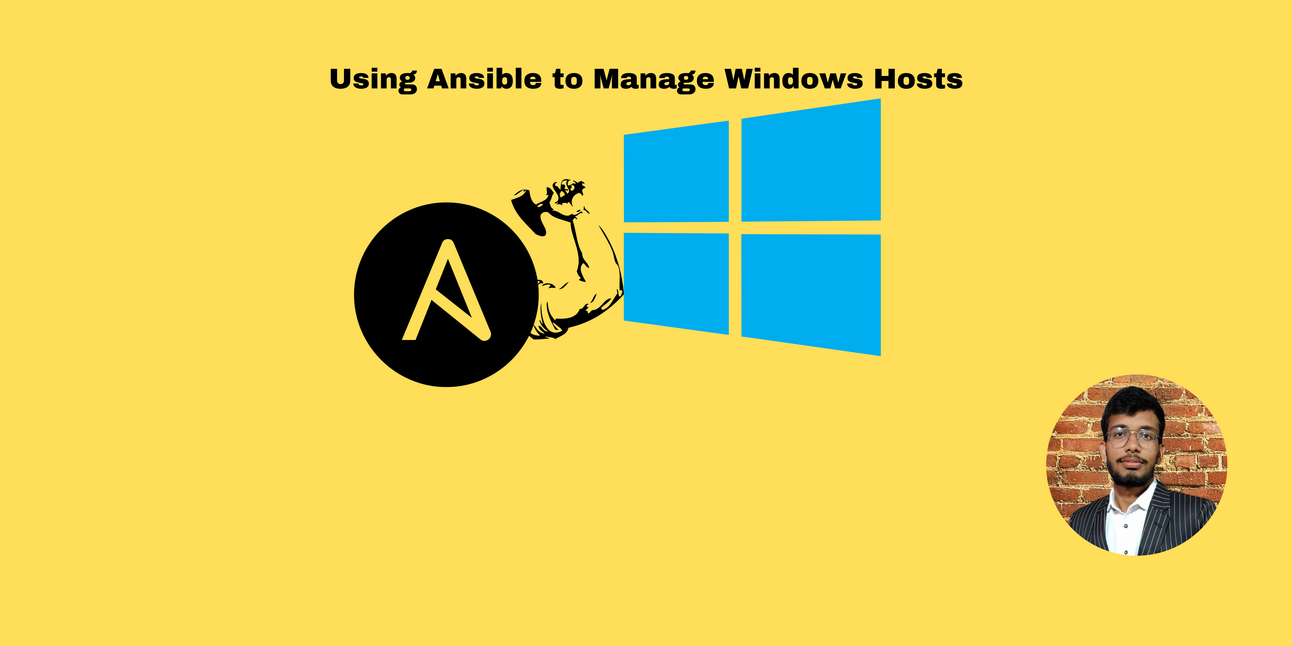Using Ansible to Manage Windows Hosts
 Rudraksh Laddha
Rudraksh Laddha
Introduction
Managing multiple computers and servers manually can be time-consuming and error-prone. Ansible is a powerful, open-source tool that automates these tasks, making it easier to manage large-scale IT environments. Originally designed for Linux, Ansible also supports Windows systems, allowing you to manage them efficiently. This article will walk you through the process of using Ansible to manage Windows hosts, explain key concepts and provide step-by-step instructions.
Key Concepts
1. Ansible: A tool that automates IT tasks such as installing software, managing configurations, and orchestrating workflows across multiple machines.
2. Playbook: A file written in YAML format that contains a list of tasks for Ansible to execute on your machines.
3. Inventory: A file that lists all the machines (hosts) Ansible will manage. This can include their IP addresses, login details, and connection methods.
4. Module: A pre-written set of instructions that Ansible uses to perform specific tasks on the hosts.
5. Task: An individual action that Ansible performs, such as installing a program or creating a file.
6. Control Node: The computer where Ansible is installed and from which you run your playbooks.
7. Managed Node: The computers or servers that Ansible manages.
Step-by-Step Process
Step 1: Install Ansible on the Control Node
First, you need a machine to act as your control node. Typically, this is a Linux machine. Here’s how to install Ansible on it:
Open your terminal.
Update your package list by running:
sudo apt updateInstall Ansible by running:
sudo apt install ansible -y
Step 2: Prepare Your Windows Hosts
Your Windows computers need to have a feature called WinRM (Windows Remote Management) enabled so that Ansible can communicate with them.
Open PowerShell as an administrator on each Windows machine.
Run the following commands:
winrm quickconfig winrm set winrm/config/client/auth @{Basic="true"} winrm set winrm/config/service/auth @{Basic="true"} winrm set winrm/config/service @{AllowUnencrypted="true"}
Step 3: Install pywinrm on the Control Node
Ansible uses a Python library called pywinrm to connect to Windows machines.
On your control node, run:
pip install pywinrm
Step 4: Create an Inventory File
An inventory file tells Ansible which machines to manage and how to connect to them.
Create a new file called
hosts.Add the following content, replacing the IP address, username, and password with your own details:
[windows] 192.168.1.100 [windows:vars] ansible_user=YourUsername ansible_password=YourPassword ansible_connection=winrm ansible_winrm_transport=basic ansible_winrm_server_cert_validation=ignore
Step 5: Write a Playbook
A playbook contains the tasks you want Ansible to perform on your Windows hosts. Let’s create a simple playbook that installs IIS (a web server) and creates a directory.
Create a file named
windows.yml.Add the following content:
--- - name: Manage Windows Hosts hosts: windows tasks: - name: Ensure IIS is installed win_feature: name: Web-Server state: present - name: Create a directory win_file: path: C:\Temp\example state: directory
Step 6: Run the Playbook
Finally, run your playbook to execute the tasks on your Windows hosts.
In your terminal, run:
ansible-playbook -i hosts windows.yml
Example Task: Installing Software on Windows
Here’s an example of a playbook that downloads and installs Notepad++ on a Windows host:
Create a new playbook file named
install_notepad.yml.Add the following content:
--- - name: Install Notepad++ hosts: windows tasks: - name: Download Notepad++ installer win_get_url: url: https://download.notepad-plus-plus.org/repository/7.x/7.9.5/npp.7.9.5.Installer.exe dest: C:\Temp\npp_installer.exe - name: Install Notepad++ win_package: path: C:\Temp\npp_installer.exe arguments: /S state: presentRun the playbook:
ansible-playbook -i hosts install_notepad.yml
FAQs
Q1: What is WinRM? A1: WinRM, or Windows Remote Management, is a protocol that allows remote management of Windows machines, enabling administrators to execute commands and manage configurations remotely.
Q2: Can I use Ansible to manage both Linux and Windows hosts? A2: Yes, Ansible can manage both Linux and Windows hosts, providing a unified approach to infrastructure automation.
Q3: Do I need to install any agents on Windows hosts to use Ansible? A3: No, Ansible is agentless. It communicates with Windows hosts over WinRM without requiring any additional software on the managed nodes.
Q4: How can I troubleshoot connectivity issues between Ansible and Windows hosts? A4: Ensure WinRM is properly configured and running on the Windows hosts. Verify network connectivity and correct credentials in the inventory file.
Q5: Is it possible to run PowerShell scripts with Ansible? A5: Yes, you can use the win_shell module in Ansible to execute PowerShell scripts on Windows hosts.
By following these steps and examples, you can leverage Ansible to manage your Windows hosts effectively, streamlining your automation processes and improving your IT infrastructure management.
#Ansible #WindowsManagement #ITAutomation #DevOps #SysAdmin #CloudComputing #InfrastructureAsCode #AutomationTools #WinRM #YAML #OpenSource #SoftwareDeployment #NetworkManagement #ITInfrastructure #Scripting
Subscribe to my newsletter
Read articles from Rudraksh Laddha directly inside your inbox. Subscribe to the newsletter, and don't miss out.
Written by

Rudraksh Laddha
Rudraksh Laddha
DevOps Engineer || Technical Writer || Content Creator || | Adventurer chasing dreams, capturing life's kaleidoscope. || 🎓UCET '24 || Dm for Collabs📥||